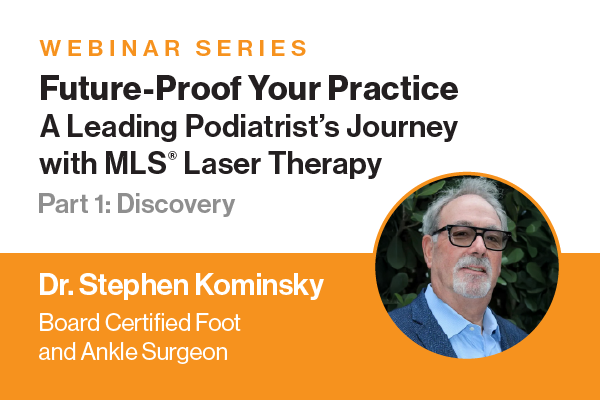Light-based therapies are growing in the field of medicine due to their ability to relieve pain and reduce inflammation for a wide range of medical conditions without the use of pharmaceutical or painful, invasive procedures.
While Lasers and LEDs use similar principles and mechanisms of action, there are differences between these therapies to take into consideration when deciding which technology is best for your practice.
Light-Based Therapies
Light is energy, and energy is essential to almost all forms of life. Decades of research have found that certain wavelengths of light on the electromagnetic spectrum can stimulate certain biological processes.
Photobiomodulation therapy (PBMT) takes advantage of this discovery by delivering light energy to biological tissue triggering a series of photochemical reactions within the body’s cells stimulating healing and leading to a reduction in pain and inflammation.
Both Lasers and LEDs built for therapeutic applications emit light at wavelengths shown to have analgesic and anti-inflammation properties. Generally, these wavelengths are within the approximate range of 650 nm to 1,200 nm on the electromagnetic spectrum. This range is often referred to as the Therapeutic Window.
While Lasers and LEDs are both capable of delivering photons (particles of light energy) at wavelength frequencies within this window, other differences between these two types light sources determine the indications they are best suited to treat.
LED
Light Emitting Diode (LED) Therapy uses light to stimulate cellular processes at or slightly below the surface level of the skin. There are three primary types of LED therapies used in medicine for different purposes: Blue, Red, and Infrared.
Blue LED light therapy is primarily used in dermatology. It is believed to improve symptoms of acne and inflammation by killing bacteria on the surface of the skin and reducing activity in the sebaceous glands to lower oil production.
Red LED light therapy is believed to reduce skin inflammation and stimulate collagen production, making it a promising approach to reduce scarring as well as signs of aging.
Infrared LED light, on the other hand, penetrates slightly deeper into the tissue than Blue and Red light and is capable of stimulating biological processes within the tissue to relieve pain, reduce inflammation, and accelerate healing.
LED therapy devices come in a wide variety of formats, including large panels for wide treatment areas or flexible pads that wrap around the extremities, enhancing the versatility of this treatment technology.
Compared to Therapy Lasers, however, LEDs typically operate at a much lower power and have a shallower penetration depth due to it’s incoherent nature. The light emitted from LED sources is divergent (the light travels in different directions from the source) and incoherent (the light contains photons oscillating at different wavelength frequencies) resulting in many limitations, particularly when the target tissue is deep within the body.
Laser
The light emitted from Laser sources are monochromatic and coherent, meaning all photons of light oscillate at the same wavelength frequency and in the same direction from the source, reducing scatter and reflection as it interacts with tissue. These properties enhance the light’s ability to penetrate deeper into the tissue and efficiently stimulate biological reactions in the cells.
Lasers provide the most flexibility in terms of treatment capabilities, granting the physician the ability to address superficial and deep set conditions.
Additionally, lasers typically have a narrower spot size than many LED devices, enhancing it’s ability to precisely and efficiently treat small, targeted areas when necessary.
Unlike LEDs, lasers are subject to the FDA’s Federal Laser Product Performance Standard and are classified into four major hazard classes.
To gain a better understanding of laser classifications, read our article Back to the Basics: Laser Classifications
LEDs vs. Lasers
When comparing LED and Laser devices, there are many other factors to consider, including clinical applications, patient outcomes, and the costs associated with these technologies.
One of the most important factors for practitioners to consider is the type of patients they see most often and how PMBT can fit within their treatment plans.
Many practitioners may be initially attracted to LED devices over Lasers due to their lower price point. Additionally, LED devices that use large panels or flexible pads may seam like a better option for large treatment areas.
However due to their limited power level and depth of penetration, these devices may not be practical for physicians looking to treat deeper conditions such as fibromyalgia, low back pain, or osteoarthritis.
A Laser’s ability to emit photons on a single wavelength frequency plays a critical role in depth of penetration, and it’s higher power output allows the laser to more efficiently transfer laser energy to that depth.
LED and Laser treatments are cumulative; Both will require the patient to undergo multiple sessions before achieving satisfactory results. The typical infrared LED treatment session can be expected to last 20 minutes, while treatment times for some Class IV Lasers (such as the Multiwave Locked System® devices) can be as little as 8 to 10 minutes. Additionally, due to a Laser’s ability to transfer energy more efficiency, patients may begin to see results sooner in the treatment plan requiring fewer treatment sessions overall.
While therapy Lasers might be a larger investment for providers, the heightened efficiency, faster outcomes, and broader clinical applications typically seen with lasers can lead to a better experience for the patient and greater opportunities for the provider.



